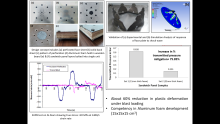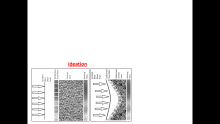Development of a Lightweight Composite Sandwich Panel for Blast mitigation
| PI Details | Co-PI Details | |||||||
|---|---|---|---|---|---|---|---|---|
|
Dr. Ranvir Singh
|
| Funding Agency | Project Cost |
|---|---|
| Defence Research and Development Organization- Armament Research Board (New Delhi) |
Rs. 43,24,304/- Amount Received till date (in Rs.) Rs. 43,24,304/- |
| Start Date | Completion Date | Status |
|---|---|---|
| 2017-06-15 | 2020-09-14 | Completed |
A design concept for making sandwich panel for blast mitigation was developed such that the designed material should be able to absorb the maximum of blast energy by undergoing elastic, plastic and fracture. Design concept include the specifically designed perforated face sheet so that after interacting with blast wave it doesn’t leave any splinters off. The specific light weight alloy of aluminum (AA6061-T6) was selected for making front and back sheet (both of 2mm thickness) of sandwich panel. Closed cell Aluminum alloy foam (AA6061) was used as central soft core. The foam was synthesized on stir casting furnace by melt route. The synthesized foam was cut into slices and sandwiched between face sheet and back sheet. The pressure value correspond to equivalent quantity of TNT and stand-off distance was investigated by simulation method. Quasi-static compression test and High strain rate test on Split Hopkinson Pressure Bar apparatus for face sheet material, central foam and back sheet material was performed to know the compressive strength. Face sheet and back sheet was tested individually on Shock tube at 46 bar reflected pressure and were analyzed. A sandwich panel was designed (11mm thick foam) and tested on shock tube which completely deformed plastically thereby absorbing some part of incident energy. Its blast mitigation capacity was increased by increasing the central foam thickness to 22 mm which resulted in very little deformation and 75.84% increase in mitigated transmitted pressure was recorded. The stress wave and strain behavior due to shock wave interaction were studied by Ansys fluent software.
| Manpower Sanctioned/Hired | Manpower Trained |
|---|---|
|
JRF (Nos): 01 |
Ph.D Produced: 01 |
|
Name of Equipment |
Make & Model |
Year of Purchase |
Cost |
Salient Features of Equipment |
Condition (Working /Not Working) |
|---|---|---|---|---|---|
|
Programmable Electrically Heated Resistance Furnace with Stirrer (& a Muffle Furnace for Preheating Mold & Particles) |
M/s. Metrex Scientific Instruments Pvt. Ltd. New Delhi
|
2018 |
Rs. 12,26,610/- |
Furnace with stirrer Batch capacity: 20 Kg (max) of Al melt Approx. Inner chamber dimensions in mm: 300 x 300 x 400 Max Temperature: 1400 ˚C Stirrer speed (Max):10 -1000 rpm
Muffle furnace Inner chamber dimensions : 300 x 300 x400 (mm) Max Temperature : 1400 ˚C |
Working |
|
Setup for Squeeze Casting |
M/s SwamEquip, Chennai
|
2020 |
Rs. 5,04,000/- |
Die (02 nos.): Cast Dimensions of 50mm OD x 250mm long (approx.) in mild steel material with maximum applied load up to 40 Tonns (adjustable). |
Working |
|
Authors Name |
Title of Paper |
Journal Name |
Volume No. |
Page No. |
Year |
DOI Number |
|---|---|---|---|---|---|---|
|
Gaurav Pal Singh, Rajvir Singh, J.D. Sharma*, Rama Arora, Inderpal Singh Sandhu
|
Shock Loading Response of Solid and Perforated Aluminum Sheets
|
Journal of Materials Engineering and Performance
|
--NIL-- |
--NIL-- |
--NIL-- |
--NIL-- |
|
Authors Name |
Title of Paper |
Name of Conference |
Place |
National/ International |
Page No. |
Year |
DOI Number |
|---|---|---|---|---|---|---|---|
|
Rajvir Singh, Rama Arora, J. D. Sharma* |
Effect of viscosity enhancing agents on quasi-static compression behavior of aluminum foams |
2nd International Conference on Recent Trends in Metallurgy, Materials Science and Manufacturing (IMME19) |
NIT Trichy (TN) |
International |
1661-1666 |
2021 |
doi.org/10.1016/j.matpr.2020.06.056 |
|
Gaurav Pal Singh, J.D. Sharma, Rama Arora, Inderpal Singh Sandhu |
CFD analysis of shock tube for blast impact testing |
International Conference on Aspects of Materials Science and Engineering (ICAMSE 2020) |
Panjab University, Chandigarh |
International |
1872-1878 |
2020 |
doi.org/10.1016/j.matpr.2020.05.294 |
- The selected design of face plate can absorb maximum of energy by undergoing elastic deformation, plastic deformation and fracture. Solid plate as a back sheet undergone plastic deformation under 42 bar pressure in shock tube.
- The decay of the total structural energy of the impact was highest for the 2mm thick Solid sample, followed by the 3mm thick Perforated and 3mm thick Solid sample. An increasing trend was observed in the total structural energy of the 2mm thick Perforated sample until the analysis was terminated at 0.70 ms. The 2mm thick Perforated sample displayed the highest total structural energy (477 J) out of all the samples.
- Design of Blast mitigation material was finalized as three-layer sandwich panel. The face plate (2mm thickness) is 7% perforated of Al6061-T6 material, central soft core is of metallic foam of Al6061 and backing plate (2mm thickness) is solid of Al6061-T6. The selected material showed the positive strain rate sensitivity.
- The thickness of sandwich panel with 22 mm thick foam has been optimized for more blast mitigation. 13.6% more energy was absorbed when the thickness of foam was increased from 11 mm to 22 mm and simultaneously about 60% reduction in central deformation was observed.
- Sandwich panel designed reduced the pressure from 42 bar reflected pressure to 0.15 bar transmitted pressure. Hence 75.85% reduction (25mm behind the sandwich panel) has been achieved by proposed design.








